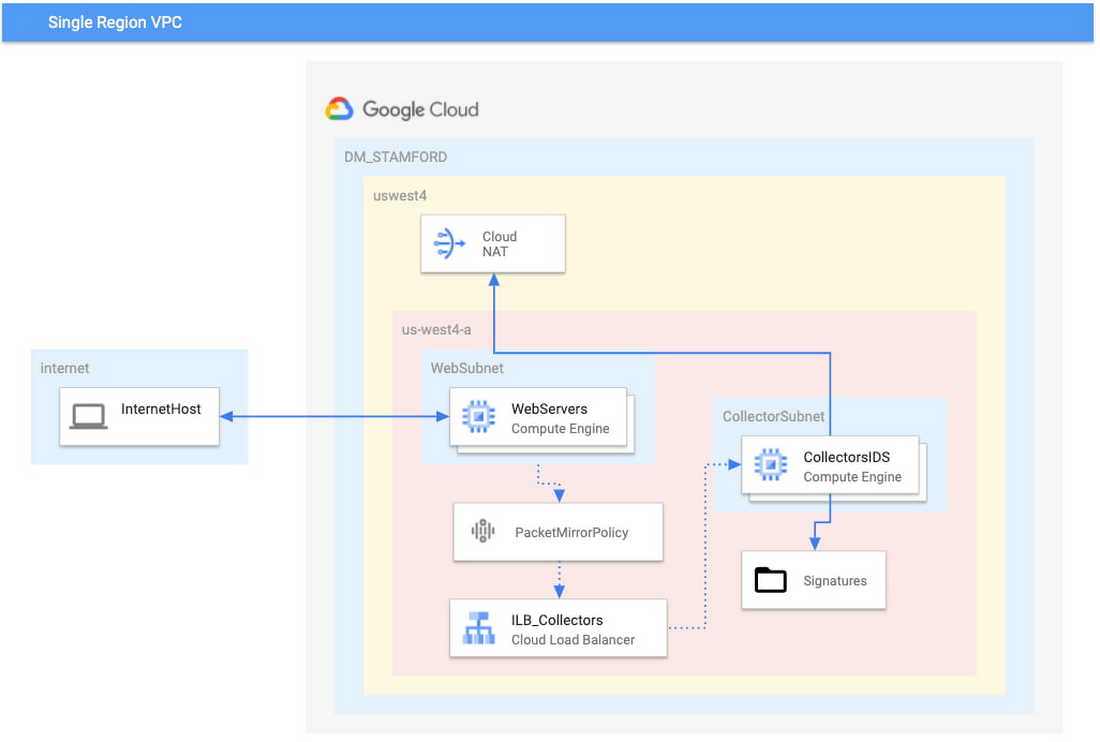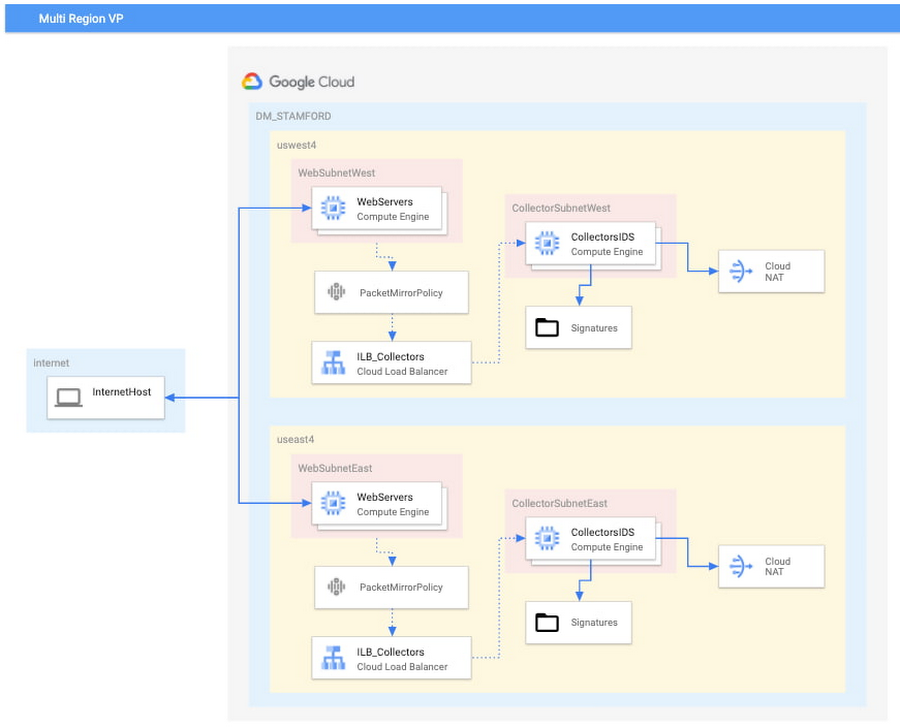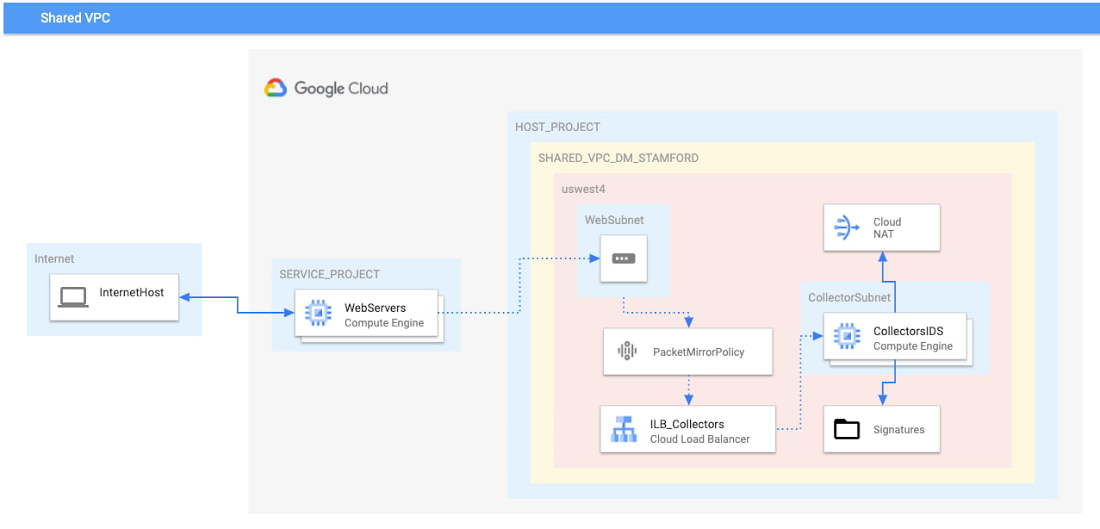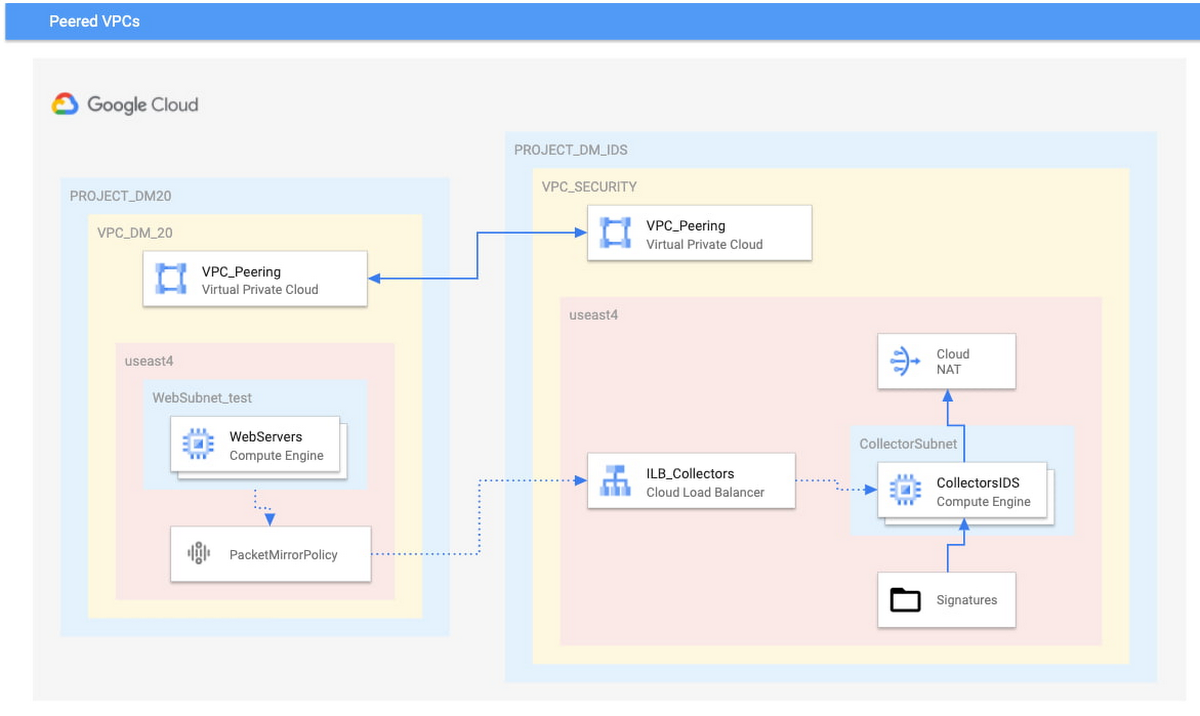How to use Packet Mirroring for IDS in different VPC designs
Jonny Almaleh
Networking Specialist
When migrating from on-premises to the cloud, many Google Cloud customers want scalable solutions to detect and alert on higher-layer network anomalies, keeping the same level of network visibility they have on-prem. The answer may be to combine Packet Mirroring with an Intrusion Detection System (IDS) such as the open-source Suricata, or some other preferred threat detection system. This type of solution can provide the visibility you need in the cloud to detect malicious activity, alert, and perhaps even implement security measures to help prevent subsequent intrusions.
However, design strategies for Packet Mirroring plus IDS can be confusing, considering the number of available VPC design options. For instance, there’s Google’s global VPC, Shared VPCs and VPC Peerings. In this blog, we’ll show you how to use Packet Mirroring and virtual IDS instances in a variety of VPC designs, so you can inspect network traffic while keeping the ability to use the supported VPC options that Google Cloud provides.
Packet Mirroring basics
But first, let’s talk some more about Packet Mirroring, one of the key tools for security and network analysis in a Google Cloud networking environment. Packet Mirroring is functionally similar to a network tap or a span session in traditional networking: Packet Mirroring captures network traffic (ingress and egress) from select “mirrored sources,” copies the traffic, and forwards the copy to “collectors.” Packet Mirroring captures the full payload of each packet, not just the headers. Also, because Packet Mirroring is not based on any sampling period, you can use it for in-depth packet-level troubleshooting, security solutions, and application-layer network analysis.
Packet Mirroring relies on a “Packet Mirroring policy” with five attributes:
Region
VPC network(s)
Mirrored source(s)
Collector (destination)
Mirrored traffic (filter)
Here’s a sample Packet Mirroring policy:


When creating a Packet Mirroring policy, consider these key points:
Mirrored sources and collectors must be in the same region, but can be in different zones—or even different VPCs or projects.
Collectors must be placed behind an Internal Load Balancer (ILB).
Mirrored traffic consumes additional bandwidth on the mirrored sources. Size your instances accordingly.
The collectors see network traffic at Layer 3 and above the same way that the mirrored VMs see the traffic. This includes any NATing and/or SSL decryption that may occur at a higher layer within Google Cloud.
There are two user roles that are especially relevant for creating and managing Packet Mirroring:
“compute.packetMirroringUser”- This role allows users rights to create, update, and delete Packet Mirroring policies. This role is required in the project where the Packet Mirroring Policy will live.
“compute.packetMirroringAdmin”- This role allows users to mirror the desired targets to collect their traffic.
Using Packet Mirroring to power IDS
An IDS needs to see traffic to be able to inspect it. You can use Packet Mirroring to feed traffic to a group of IDSs; this approach has some significant benefits over other methods of steering traffic to an IDS instance. For example, some cloud-based IDS solutions require special software (i.e., an agent) to run on each source VM, and that agent duplicates and forwards traffic to the IDS. With Packet Mirroring, you don’t need to deploy any agents on VMs and traffic is mirrored to IDS in a cloud-native way. And while an agent-based solution is fully distributed and prevents network bottlenecks, it requires that the guest operating system support the software. Furthermore, with an agent-based solution, CPU utilization and network traffic on the VM will most certainly increase because the guest VM and its resources are tasked with duplicating traffic. High CPU utilization related to network throughput is a leading contributor to poor VM performance.
Another common approach is to place a virtual appliance “in-line” between the network source and destination. The benefit of this design is that the security appliance can act as an Intrusion Prevention System (IPS) and actually block or deny malicious traffic between networks. However, an in-line solution, where traffic is routed through security appliances, doesn’t capture east-west traffic within VMs in the same VPC. Because subnet routes are preferred in a VPC, in-line solutions which are fed traffic via static routes, can’t alert on intra-VPC traffic. Thus, a large portion of network traffic is left unanalyzed; a traditional in-line IDS/IPS solution only inspects traffic at a VPC or network boundary.
Packet Mirroring solves both these problems. It doesn’t require any additional software on the VMs, it’s fully distributed across each mirrored VM, and traffic duplication happens transparently at the SDN layer. The Collector IDS is placed out-of-path behind a load balancer and receives both north-south traffic and east-west traffic.


Using Packet Mirroring in various VPC configurations
Packet Mirroring works across a number of VPC designs, including:
Single VPC with a single region
Single VPC with multiple regions
Shared VPC
Peered VPC
Here are a few recommendations that apply to each of these scenarios:
Use a unique subnet for the mirrored instances and collectors. This means if the mirrored sources and the collectors are in the same VPC, create multiple subnets in each region. Place the resources that need to be mirrored in one subnet and place the collectors in the other. There is no default recommended size for the collector subnet, but make sure to allocate enough space for all the collectors that might be in that region plus a little more. Remember, you can always add additional subnets to a region in Google Cloud.
Don’t assign public IPs to virtual IDS instances. Rather, use CloudNAT to provide egress Internet access. Not assigning a public IP to your instances helps them from being exposed externally to traffic from the internet.
If possible, use redundant collectors (IDS instances) behind the ILB for high availability.
Now, let’s take a look at these designs one by one.
Single VPC with a single region
This is the simplest of all the supported designs. In this design, all mirrored sources exist in one region in a standard VPC. This is most suitable for small test environments or VPCs where network management is not dedicated to a networking team. Note that the mirrored sources, Packet Mirroring policy, collector ILB and the IDS instances, are all contained to the same region and same VPC. Lastly, CloudNAT is configured to allow the IDS instances internet access. Everything is contained in a single region, single VPC, and single project.


Single VPC with multiple regions
Because mirrored instances and collectors must be in the same region, it stands to reason that a VPC that contains subnets in multiple regions needs multiple collectors, multiple ILBs and multiple Packet Mirroring policies. To account for multiple regions, simply stamp out a similar deployment to the one above multiple times. We still recommend using CloudNAT.
The following example shows a single VPC that spans two different regions, however, a similar architecture can be used for a VPC with any number of regions.


Shared VPC
Packet Mirroring also supports Shared VPC. In this example, the collectors (IDSs), ILB and the Packet Mirroring policy all exist inside the host project. The collectors use their own non-shared subnet. The mirrored sources (WebServers), however, exist inside their service project using a shared subnet from the Shared VPC. This allows the deployment of an IDS solution to be left up to the organization’s cloud network operations group, freeing application developers to focus on application development. CloudNAT is configured to allow the IDS instances Internet access.


Peered VPC
Packet Mirroring also supports when collectors and mirrored sources are in different VPCs that are peered together, such as in a hub-and-spoke design. The same requirements for mirroring traffic between VPCs are applicable. For example, the collector and mirrored sources must be in the same region. In the below example, the mirrored sources (WebServers) and the Packet Mirroring policy exist in VPC_DM_20 in the DM_20 project. On the other side, the ILB and collectors (IDSs) exist in the peered VPC named VPC_SECURITY in the DM_IDS project. This allows the users in the source VPC to selectively choose what traffic is forwarded to the collector across the VPC peering. CloudNAT is configured to allow the IDS instances internet access. Keep in mind the Packet Mirroring role requirements between the different projects. Proper IAM permissions must be configured.


Don’t sacrifice network visibility
Using Packet Mirroring to power a cloud IDS solution, whether it’s open-source or proprietary, is a great option that many Google Cloud customers use. The key is where to place your collectors, ILBs and the Packet Mirroring policy itself—especially when you use a more advanced VPC design. Once multiple VPCs and GCP projects get introduced into the deployment, the implementation only becomes more complex. Hopefully, this blog has shown you how to use Packet Mirroring with an IDS in some of the more common VPC designs. For a hands-on tutorial, check out QwikLabs’ Google Cloud Packet Mirroring with OpenSource IDS, which walks you through creating a VPC, building an IDS instance, installing Suricata and deploying Packet Mirroring.


